Launching a small pasta processing line can be an exciting pursuit, regardless of whether you want to join the food sector or turn your cooking passion into a business. This guide aims to give you a general understanding of the fundamental aspects and factors related to starting your own pasta production line. Everything from picking out appropriate machinery and grasping the production process to complying with laws and figuring out who your customers are going to be will be covered so that you can have everything needed for the successful start-up of the pasta venture. With this article, we hope to provide you with practical knowledge on making high-quality pasta that is competitive enough in the market by using business tips and industry insights.
What is a small pasta production line?
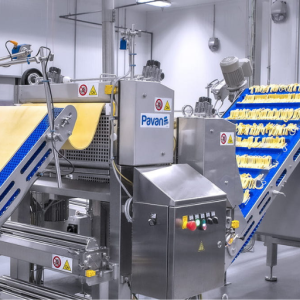
Image source: https://www.gea.com/
The small-scale pasta production line is a small and efficient unit tailored to the needs of those who manufacture pasta on a smaller scale, for instance, artisans or niche players in the market. The assembly usually comprises mixers, extruders, and drying machines, which are key components for producing different types of pasta. It allows room for maneuvering, allowing producers to try out new formulas and shapes while maintaining the quality and quantity of their products. This arrangement suits small entrepreneurs or culinary enthusiasts who venture into the pasta business without investing heavily in large industrial equipment.
Key Components of a Small pasta production line
- Mixers: First, when making pasta, mix the ingredients to get the dough consistency that comes from blending, mainly flour and water. Most small-scale production line industrial mixers have variable speed settings to make different kinds of dough.
- Extruders: After mixing, it is then pushed through an extruder, which shapes the pasta into what you want it to be, such as spaghetti or penne, among others. Small-scale operation extruders are characterized by compactness and flexible size and shape adjustments.
- Drying Machines: This is followed by drying after the pasta has been formed to ensure its durability and texture. Drying machines fit for small production lines are characterized by controlled temperature and airflow, ensuring uniform drying without compromising quality.
These components combine to streamline and optimize a small-scale pasta-making process, allowing producers to concentrate on excellence and innovation while still being efficient.
How Does a Short-Cut Pasta Production Line Work?
The manufacture of short-cut pasta consists of several well-defined stages aimed at creating many varieties out of basic ingredients. The line begins with the blending process between flour and water using industrial mixers to produce a uniform dough. This dough is then passed through an extruder, forming shapes like macaroni or fusilli. The extrusion phase is vital since it determines the final shape of the pasta; hence, the extruder allows quick changing of styles.
After being extruded, fresh pasta is transported into driers, which utilize regulated temperatures to eliminate moisture while maintaining texture and taste. These machines ensure that pasta is uniformly dried for good shelf stability. Lastly, after drying, packaging follows. From mixing to packaging, this efficiency enables small-scale producers to maintain high quality and affordable production costs, creating an excellent opportunity for small-scale businesses involving the pasta industry.
What Types of Pasta Can Be Produced?
A short-cut pasta production line can produce many types of pasta shapes. Hence, each has unique textures and culinary uses. Some of the common ones are:
- Macaroni: This is a kind of short, tubular pasta for casseroles and salads.
- Penne: Cut diagonally with grooved surfaces. They hold sauces well.
- Fusilli: Thick sauces go excellent with the spiral-shaped pasta; it has a solid bite.
- Farfalle: Often used in pasta salads or with light sauces, it is the bow-tie-shaped pasta.
- Rigatoni: Excellent for baked dishes and rich sauces; these are larger tubes ridged inside them
These shapes cater to diverse recipes and preferences, allowing producers to meet various market demands while innovating new pasta creations.
What machinery is needed for a small pasta factory?
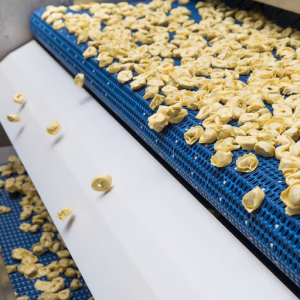
Several machines are essential to driving the effective production of a small pasta factory. The following equipment is primary.
- Mixer: It helps make the first dough by blending flour and water.
- Extruder: This machine is crucial for forming pasta as it comes with different dies to create various pasta profiles.
- Drying Machine: This process eliminates moisture from the noodles while still perfecting their taste and quality; hence, it is important because of its shelf stability.
- Cutting Machine: It sizes pasta shapes accurately after extrusion.
- Packaging Machine: This machine aids in effectively packing dry pasta into bags or boxes for distribution purposes.
Investment in these machines makes production more efficient and ensures that final products are of high quality and consistent.
Essential Equipment for Pasta Production
Several pieces of essential equipment are necessary to effectively establish a small pasta factory, as seen from various industry sources.
- Dough Mixer: Flour and water are mixed by this machine to produce a uniform dough that is the basis for excellent pasta.
- Pasta Extruder: This machine gives different shapes and sizes of pasta by pushing prepared dough through particular dies.
- Drying Equipment: Well-ventilated drying machines dry off the pasta to reduce its moisture content, improving its shelf life and texture.
- Cutter: The cutting machine achieves uniformity in the size of short pasta shapes, making it possible to produce various shapes.
- Packaging Machine: It seals freshly made pastas to preserve quality and be ready for distribution at retail centers.
Purchasing such machinery can streamline production while assuring end-products meet anticipated consumer quality standards.
The Role of pama parsi macchine in pasta Manufacturing
Advanced machinery from Pama Parsi Macchine is important in pasta production because they are efficient and produce quality products. Their machines also facilitate accurate blending, squeezing out, and separating to maintain the set standards at every stage of manufacture. Pama’s dryers aim at optimum water removal to increase pasta shelf stability. Furthermore, their packing solutions safeguard the product during movement and storage. In conclusion, companies manufacturing pasta can easily establish uniformity and throughput by assimilating Pama Parsi’s equipment into their factory lines; hence, they can meet consumer needs without compromising on taste and standards improvement.
Choosing the Right Pasta Maker for Small-Scale Production
When choosing a pasta machine for small-scale production, there are several important factors to consider:
- Size and Capacity: A compact model is ideal since it uses space effectively while meeting the objective. When operating on a limited scale, these machines do not necessarily need much space but should be capable of producing well.
- Ease of Use: Choose a pasta machine that’s easy to use by anyone and can be set up quickly at any moment. This will reduce the time it takes for training sessions so that everyone knows how to produce more within shorter periods.
- Versatility: It may be helpful if the machine can make various types of pasta in different sizes. This will enable you to cater to consumer preferences and market trends.
- Quality of Build: Look for a robustly built pasta maker made from quality materials. Operating in an industrial setting demands reliability and durability, which results from investing in such a device.
- Cost-Effectivity: The cost should also be considered against the features provided. Therefore, one needs to strike a balance between price and necessities without digging into one’s pockets unnecessarily.
These elements must be considered while researching top alternatives available to find efficient solutions that would serve purposes in specific situations faced by small-scale producers today.
How do you start a small pasta factory?
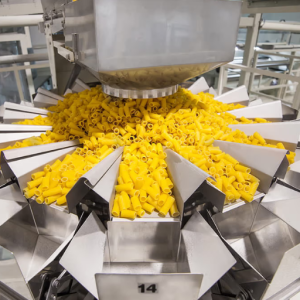
To begin a small pasta factory, one must follow specific key steps. One of them is conducting marketing research to identify the target audience and their preferences, thereby ensuring demand for the product. Secondly, make an elaborate business plan, including your vision, production processes, and financial projections. It is often important to obtain some money through personal savings or loans from banks. Thereafter, it involves choosing a suitable location that meets zoning requirements and has enough space for equipment and storage purposes. Some factors, such as capacity, should be considered when buying high-quality pasta-making machinery. Finally, get good ingredients for the pasta noodles, establish suppliers’ relationships, and go through permits and food safety regulations on a parallel basis. You can successfully launch your small-scale pasta factory by working hard to achieve your goal with careful planning.
Initial Setup and Costs for a Small Pasta Factory
When establishing a small pasta factory, there are several initial costs and setups to consider. First, purchasing equipment is a significant upfront expense that includes pasta makers, mixers, and drying machines, costing between a few thousand to tens of thousands of dollars, depending on the production scale and quality. Secondly, facility costs should be considered, including leasing or buying space that satisfies health safety requirements, which may differ greatly between locations. Another cost that will need careful budgeting based on the production volume is raw materials like flour and eggs.
Another crucial part is the licenses and permits, which may differ from one region to another but are mandatory for food safety compliance. Lastly, funding for utilities and the workforce should also be provided because they influence the overall operational budget. Thorough financial planning involving these expenditures can help achieve a successful launch and sustainability of a small pasta factory.
Legal Requirements and Regulations for Pasta Production
Setting up a pasta factory and navigating through different legal obligations and regulations to ensure they comply with the food safety standards. Food businesses need to register with the health authorities of their jurisdictions and obtain necessary permits. Often, this entails submitting applications that explain production processes and facility plans.
Secondly, in the United States, adherence to Food and Drug Administration (FDA) Rules is essential; this includes compliance with the FDA’s Good Manufacturing Practice (GMP) guidelines by pasta makers, which prescribe sanitary production practices, employee hygiene, and proper storage conditions.
Complying with the labeling laws is also crucial. The FDA’s Food Labeling Guide requires all packed pasta to be accurately labeled, stating their constituents, nutrition data, and allergen content.
Finally, producers need to know state-specific regulations, such as extra inspections or permits, and international standards if exporting products. It is important to contact a lawyer who deals with food production and can help understand how to meet all legal requirements.
Setting Up Your Contact Form and Sales Channels
It is crucial to have effective contact forms and sales channels in place that will enable you to communicate better with customers and facilitate sales in your pasta factory. You can begin by ensuring that you create a user-friendly contact form through which all significant information, such as names, emails, special requests, and others, can be gathered for smooth communication and easy accessibility.
The next aspect to consider is the use of various sales channels. Examples include e-commerce websites, social media marketplaces, and local food delivery services. Websites like Shopify or WooCommerce have great tools for creating online stores where one can exhibit their products effectively while simplifying purchasing them. Furthermore, being active on social networking sites like Instagram and Facebook acts as a means for promotion and interaction among buyers.
Finally, if you want your consumers’ payment experiences to go smoothly, you need effective processing systems in place. Methods such as PayPal or Stripe may improve safety and convenience, which would ultimately lead to a high conversion rate.
What are the production processes in a small pasta production line?
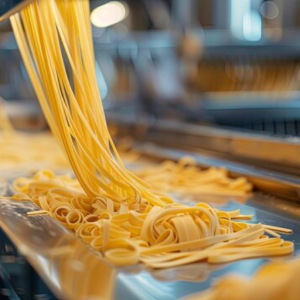
In small pasta productions, production processes generally comprise several significant steps. To begin with, the ingredients are blended in specific proportions to form dough made of flour and water. The dough is then kneaded to acquire the necessary texture and constancy. When ready, it is rolled out and shaped into various shapes by cutting or extrusion methods. Once formed, their moisture is removed through drying to prolong their shelf-life. At last, they are packed for sale after being dried for some time. Quality control measures remain important throughout these processes to ensure that the final product meets industry standards and customers’ expectations.
The Fresh and Dry Pasta Production Process
The distinction between fresh and dry pasta in production is mainly about moisture and how to keep it fresh.
- Making Fresh Pasta: It is made from good-quality flour, eggs, and water. The ingredients are mixed to form a dough, which is then kneaded and rolled out until it becomes thin sheets. These sheets can be cut into various shapes, such as fettuccine or lasagna. Fresh pasta is typically cooked immediately after production, and its short shelf life is due to the moisture content.
- Dry Pasta Manufacturing: The process of making dry pasta begins with mixing semolina flour with water; however, unlike the former, the dough is extruded through a die to get different shapes and then dried. This drying process drastically reduces moisture, thus allowing for extended storage without refrigeration. Pasta drying requires precise temperature control and duration, ensuring its quality and nutritional value remain intact.
Both processes emphasize utilizing superior ingredients and maintaining strict quality control so that the final products meet customers’ expectations/requirements and industry standards.
Role of machinery in pasta processing
In the pasta industry, machinery is vital for process efficiency, uniformity, and quality throughout production. The automatic mixing machines ensure that their components are mixed evenly and thoroughly, while the kneading machines make dough with a homogenous texture for fresh and dry pasta. These extrusion machines reduce labor costs by shaping dough into different forms of pasta. On the other hand, industrial dryers are essential in manufacturing dried pasta since they monitor temperature and humidity to remove moisture without compromising quality. Lastly, packaging machines assist in fast and secure packing so that final products have longer shelf life yet remain of good quality to the consumer. Consequently, advanced machinery makes it possible to produce at minimum cost and ensures compliance with strict standards of quality for this product.
Packaging and Production Capacity Considerations
Several important considerations are made when evaluating packaging and production capacity in the pasta industry. To begin with, efficient packaging design is vital to keep freshness and extend shelf life, and often, it relates to materials that act as moisture barriers and light filters. Also, machinery capabilities and layouts affect the production capacity of manufacturers’ facilities. As per leading industry sources, enhancing production lines through automation can dramatically enhance output without compromising on quality while at the same time lowering waste levels. Lastly, adherence to food safety regulations during production and packaging ensures that apart from meeting consumer expectations, the final product complies with legal standards, too.
What solutions and innovations exist for small pasta production?
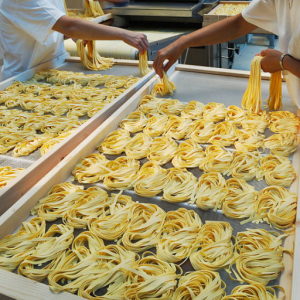
There are multiple ways to make small pasta production more efficient and improve quality. A good example is the development of compact, multifunctional pasta machines that integrate mixing, extruding, and drying processes into one unit to save space and cut labor costs. Moreover, they can use digital technologies like smart sensors and automated monitoring systems to optimize production conditions and detect real-time data on quality parameters. Sustainable practices such as using local ingredients or environmentally friendly packaging materials are also becoming popular among people who value nature. At the same time, many small firms have started selling their products online via e-commerce platforms, further penetrating the market and leading to increased profitability through direct consumer sales.
Sustainable Practices in Pasta Manufacturing
In this regard, sustainable practices in pasta manufacturing aim to reduce the environmental effects while upholding quality production. Many leading companies are now using organic grains and implementing water-efficient methods as one of their approaches. Apart from that, other producers are going for energy-efficient equipment and renewable energy to run their factories, which largely reduces carbon emissions. A brand is enhanced through sustainable options to appeal to eco-conscious customers with green packaging solutions such as biodegradable materials or products. Transparency regarding sourcing and production procedures is critical to developing trust and loyalty among consumers who consider sustainability in their purchase choices when buying ingredients for sustainable pasta. In doing so, they help preserve the environment while tapping into an emerging market of sustainably conscious buyers.
Modern automatic machinery Features
The present-day automatic machinery for producing pasta manufacturing has developed several advanced features meant to improve its efficiency and productivity. The main functions include CNC technology for accurate processing, facilitating the precision shaping and cutting of pasta products. Furthermore, automation involves inbuilt sensors that control production parameters, ensuring uniform quality control. Moreover, simple-to-use interfaces are utilized, which enable operators to handle operations and changes with minimal training easily. Recently, robots have been incorporated into packaging processes, lowering labor costs and increasing output volume. Moreover, modern systems increasingly employ IoT connectivity for remote monitoring and analysis, thus offering valuable insights to manufacturers for continuous improvement and predictive maintenance. In summary, these functionalities guarantee high standards by the pasta makers in instances where market forces shift preferences.
Customization Options for pasta shapes
With pasta shapes, customization options have greatly expanded, enabling manufacturers to care for various culinary preferences and regional specialties. Some companies now make custom pasta types in collaboration with chefs and restaurants who create new types unique for certain dishes. For popular custom sizes of extruded shapes, such as fusilli or penne, others may use hand-rolled techniques to produce artisanal variants, such as gnocchi or tortellini. Moreover, some producers mix diverse ingredients, including whole grains, spinach, or beetroot, that will result in colorful, flavored pastas enhancing the visual appeal and matching nutritional needs. Such levels of personalization help brands differentiate themselves, attracting buyers seeking customized, high-quality pasta experiences amidst competition.
Frequently Asked Questions (FAQs)
Q: What are the essential pieces of machinery and equipment needed to set up a small pasta production line?
A: To set up a small pasta production line, you’ll need several key pieces of equipment, including a pasta machine, dough mixer, sheeters, and dryers. Depending on the type of pasta you plan to produce, you might also need equipment to make specific pasta shapes, such as ravioli or macaroni.
Q: Can I produce fresh and dry pasta with the same machinery?
A: Many pasta machines are versatile enough to handle fresh and dry pasta production, but you may need additional equipment, like a dryer, to complete the drying process correctly.
Q: How do I ensure that my pasta is high quality?
A: To ensure high-quality pasta, it’s crucial to use well-made, commercial-grade equipment and ensure your processing line is set up to cater to your needs. Using a reputable supplier for your pasta equipment and maintaining your machinery correctly will also help maintain quality.
Q: Is it possible to get a pasta processing line that fits within Canada?
A: Some suppliers can provide pasta machinery and equipment tailored to Canadian regulations and standards. It is advisable to work with a supplier with experience in the Canadian market to ensure your equipment is compliant.
Q: How do I choose the pasta machine for my small production line?
A: Choosing the right pasta machine depends on the type and volume of pasta you intend to produce. Look for machines that have commercial-grade quality and can produce the shapes you want, like lasagne, cannelloni, or spaghetti. Consult with a supplier to match the machine to your specific needs.
Q: What types of pasta can be produced with a basic pasta machine?
A: A basic pasta machine is typically capable of producing a variety of pasta shapes, including ravioli, cappelletti, short-cut pasta (short pasta), spaghetti, and even different forms of fresh pasta and gastronomy items.
Q: How do I ensure the pasta production machines work great over time?
A: Regular maintenance, proper cleaning, and periodic inspections ensure your pasta machines work great over time. Follow the manufacturer’s guidelines and schedule regular servicing to prevent any issues.
Q: What are the storage requirements for fresh pasta produced in a small production line?
A: To maintain quality, fresh pasta should be stored in a cool, dry place. Trays and proper packaging can help with storage, and if you’re not going to use or sell the pasta quickly, consider using a refrigeration unit to keep it fresh longer.
Q: How quickly can I deliver and set up my pasta equipment?
A: Delivery times can vary depending on the supplier and the specific equipment you order. However, many suppliers offer expedited shipping options, and some customers report that their machinery arrived extremely quickly. It is best to confirm delivery timelines with your supplier during the purchasing process.
Q: Are there any specific requirements for producing different types of pasta, such as short pasta, macaroni, or cannelloni?
A: Yes, producing different types of pasta, such as short pasta, macaroni, or cannelloni, may require specific dies or attachments for your pasta machine. Check with your equipment supplier to ensure you have the necessary tools to produce the desired varieties.














